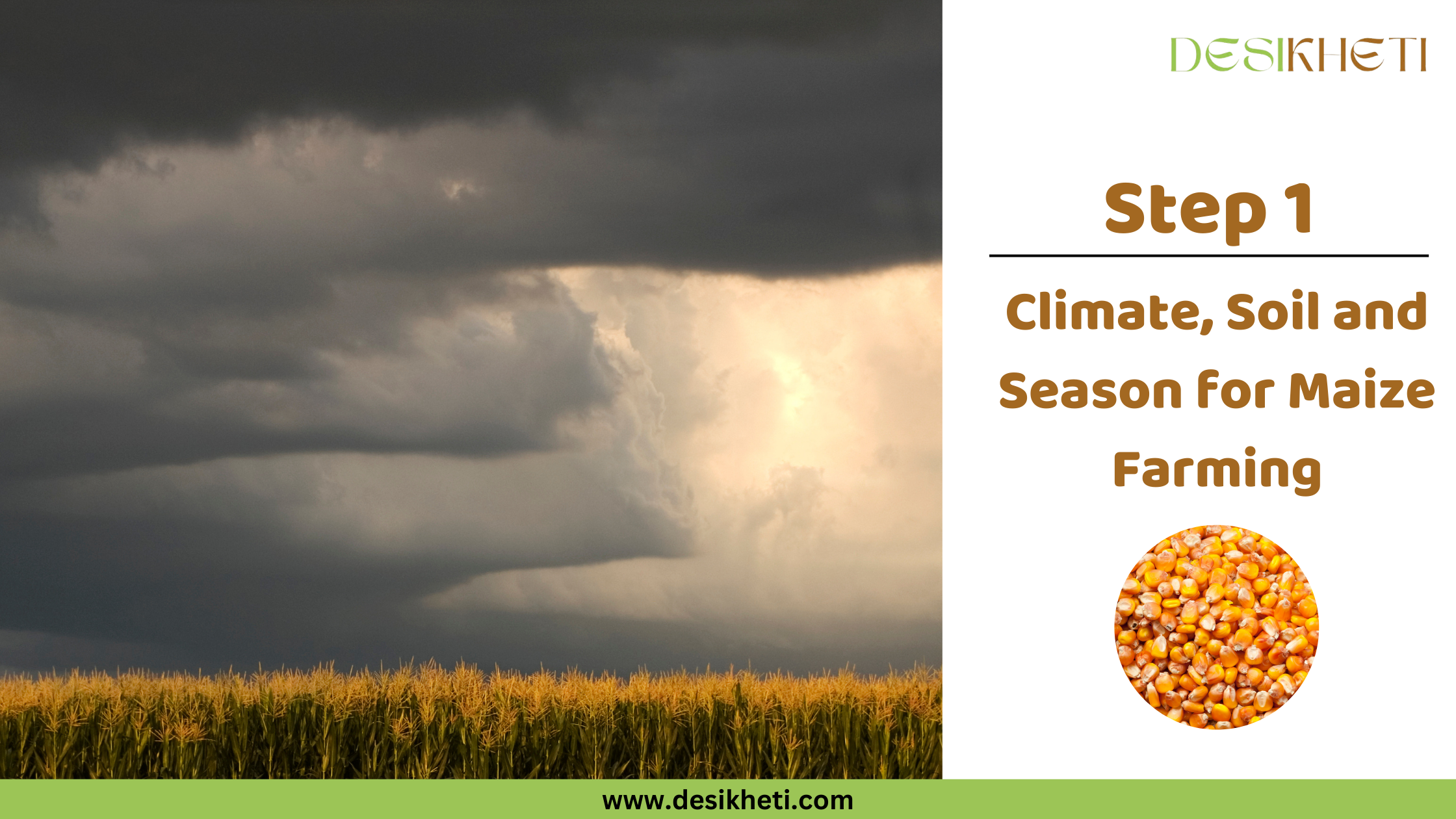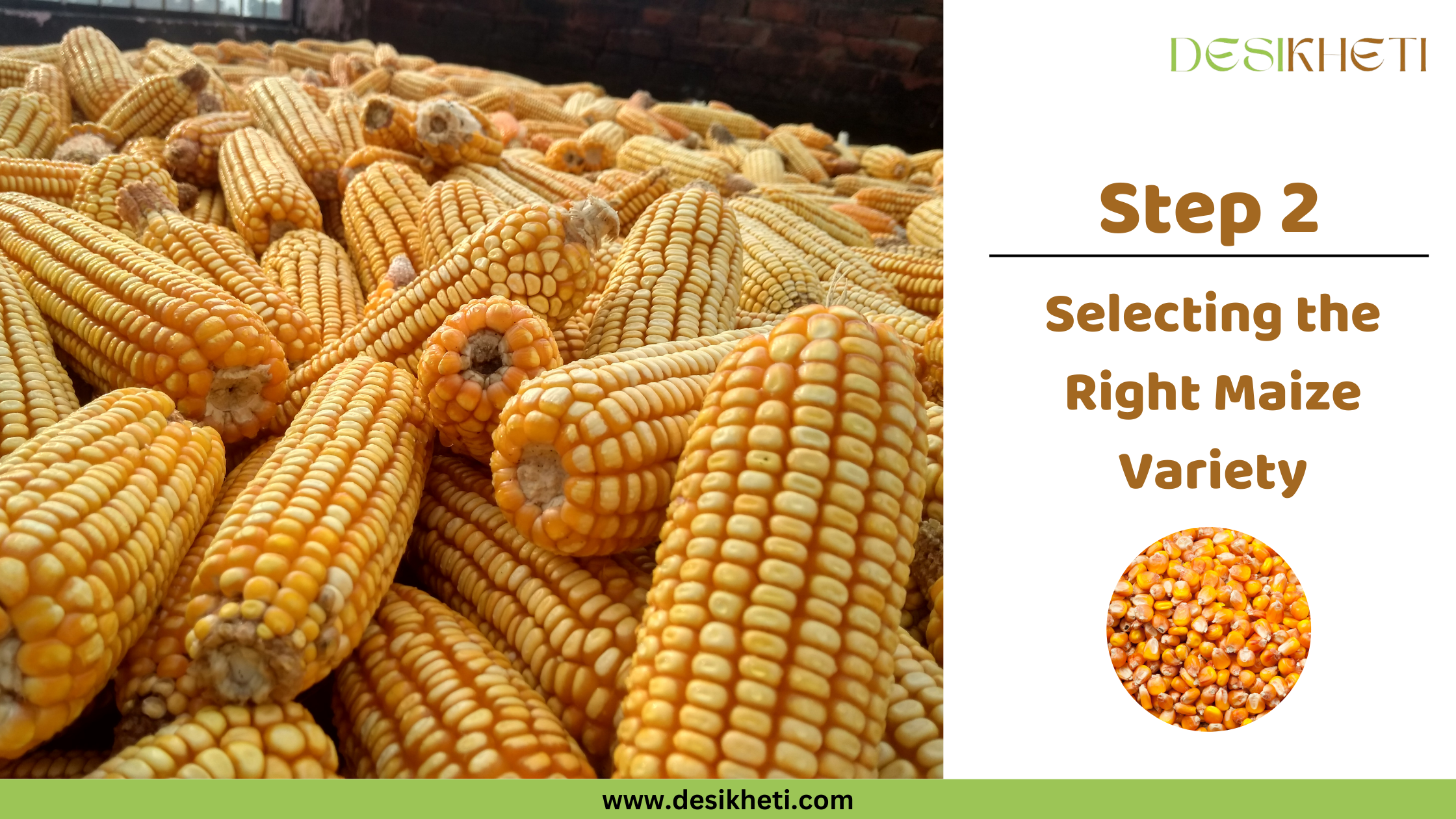Table of Contents
Introduction
Maize, often called the “Queen of the Cereals,” is one of the world’s most important crops, serving as a food source, green forage, and a crucial industrial raw material. It plays a key role in various industrial applications, ranging from food products to biofuels and textiles.
Interested in starting maize farming? In this blog, we’ve outlined 7 simple steps to sow maize seeds and kickstart your maize farming journey.

Step 1: Climate, Soil, and Season for Sowing Maize Seeds

Climate for Maize Cultivation
Maize is a tropical crop; however, it is grown under extremely diverse climatic conditions across the world, ranging from tropical to temperate regions. Generally, it does not grow satisfactorily in semi-arid areas.
Maize thrives in warm and humid weather. It performs best in regions with moderate temperatures, where the night temperature stays above 15°C and the optimal daytime temperature ranges between 21°C and 32°C. The crop is highly sensitive to extreme weather; frost can cause severe damage at any stage, while excessive heat and humidity during flowering can hinder pollination and grain formation. For optimal growth, maize requires around 600 mm of evenly distributed rainfall throughout the season.
Soil for Maize Cultivation
Maize can be grown in a variety of soils, from sandy loams to clay loams. However, for best yields, it requires well-drained, fertile soil enriched with organic matter. Sandy loam soils are preferred in sub-humid regions, while in semi-arid areas, maize can be cultivated on deep, heavy-textured soils that retain moisture well. The ideal soil pH for maize ranges between 6.5 and 7.5. Salinity and waterlogged conditions are harmful, especially at the seedling stage.
Season for Maize Cultivation
Maize is cultivated during all three seasons in India. In the Kharif season, sowing begins with the onset of the monsoon in June to July. As a Rabi crop, it is generally sown under irrigated conditions during October to November. For summer cultivation, maize seeds are sown between February and March.
Step 2: Selecting the Right Maize Variety

Various factors such as the season of cultivation, length of the growing season, grain color, water availability, and climate need to be considered while selecting a maize variety. For your convenience, a few maize varieties are listed below.
Step 3: Procuring Quality Maize Seeds

For successful maize farming, selecting high-quality seeds is essential. Even with the best cultivation practices, poor-quality seeds can lead to low yields and weak plant health. Looking for the best maize seeds? DesiKheti offers a wide range of premium maize seeds tailored to your farming needs. Browse our collection, place your order online, and have it delivered to your doorstep.
Step 4: Land Preparation for Sowing Maize Seeds

Two to three shallow tillage operations help in weed control and moisture conservation. Deep ploughing further improves soil aeration and enhances water retention. After tilling, the soil can be leveled to prevent waterlogging. Apply 10 to 15 tons of Farmyard Manure during the final ploughing.

Step 5: Sowing Maize Seeds

Seed Rate: The average seed rate is 8 to 10 kg of maize seeds per acre of land. However, the exact seed rate may vary based on the sowing method, spacing, and other factors.
Seed Treatment: Seeds sold by private companies are often pre-treated with chemicals. However, if your maize seeds are not pre-treated, treat them with carbendazim at 2 g per kg of maize seeds.
There are different methods of sowing maize seeds, and specific techniques work best for different regions. The ridge and furrow or bed and furrow systems are ideal for semi-arid and sub-humid areas, ensuring better drainage and root development. In high-rainfall regions, poor drainage can lower yields, so techniques like Zingg terracing are practiced to prevent waterlogging and improve productivity.
Maize seeds can be broadcast in the field, or dibbling can be done. Dibbling is preferred as it results in uniform plant spacing. Generally, maize seeds are dibbled on the side of the ridges at a distance of ⅓ from the top of the ridge. The seeds are dibbled at a depth of 2–3 cm, and the depth should not exceed 5 cm.
In the Zingg terracing method, maize is grown in the upper ¾ of the plot, which is sloped to help with quick drainage. Rice is grown in the remaining ¼ of the area, which is leveled to accommodate runoff from the upper portion of the plot.
Step 6: Care After Sowing Maize Seeds

Water Management:
Maize is highly sensitive to both drought and waterlogging, making proper water management crucial for good yields. Up to 40 DAS (Days After Sowing), the crop is more sensitive to excess moisture, and from pre-flowering to maturity, it is more sensitive to drought. The crop requires around 600 mm of water.
Light, frequent irrigations that moisten the root zone are more effective than heavy irrigation at long intervals. Generally, irrigation can be given once every 6 to 10 days, depending on the weather, soil moisture, and other factors. The flowering stage (tasseling and silking) is the most critical period for moisture; any stress during this stage can drastically reduce yields. Therefore, proper irrigation must be ensured during this time.
Weed Management:
Timely weed control is important. The first 6–7 weeks of maize growth are the most critical period for weed competition. Proper and timely intercultivation helps with aeration by loosening the surface soil and contributes to good yields. Two intercultivations and two hand weeding can be done. Ensure that intercultivation is not done too close to the plants or too deep, to avoid injury to the growing roots of the maize plant.
Step 7: Harvesting Maize

Maize hybrids typically mature within 90–110 days. A simple test for maturity is that the husk turns pale brown, and the grains are too hard to be pressed with fingernails. The ideal time to harvest is when the grain moisture is around 20%.
The plants may still be green, so it is important not to wait for the stalks to dry completely, as this can delay harvesting and reduce grain quality. Additionally, the green stalks can be used as fodder, making timely harvesting beneficial for both grain production and livestock feed.

Common FAQs Related to Maize Seed Sowing
Q. What climate is best for growing Maize?
A. Maize thrives in warm, humid climates with moderate temperatures. The optimum temperature for maize growth is between 21°C and 32°C during the day, with a nighttime temperature above 15°C.
Q. Which soil is best for growing Maize?
A. Maize can be grown in a wide range of soils. The crop grows best in well-drained, fertile soil rich in organic matter.
Q. What is the seed rate for Maize?
A. The average seed rate for maize is 8 to 10 kg per acre. However, the exact seed rate may vary depending on the sowing method, spacing, and other factors.
Q. When should Maize be harvested?
A. Maize can be harvested when the husk turns pale brown and the grain is hard enough that it cannot be pressed with fingernails. The ideal grain moisture content for harvesting is around 20%.
Q. How deep should Maize seeds be sown?
A. Maize seeds can be sown at a depth of 2–3 cm, with a maximum depth of 5 cm.
Q. What is the scientific name of Maize?
A. The scientific name of maize is Zea mays.

Join DesiKheti Whatsapp Channel for regular updates, farming tips, and information on agriculture.
